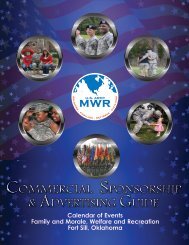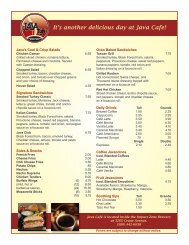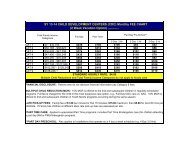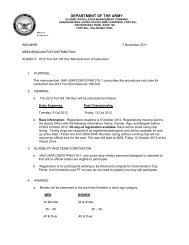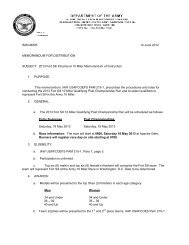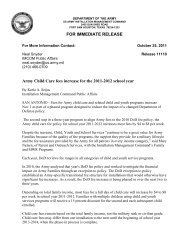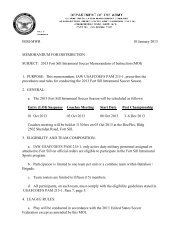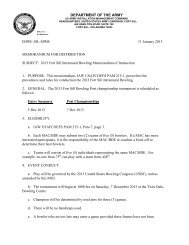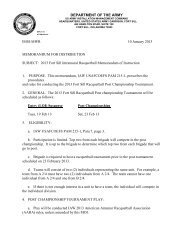Preparing and Managing Correspondence - Fort Sill MWR
Preparing and Managing Correspondence - Fort Sill MWR
Preparing and Managing Correspondence - Fort Sill MWR
Create successful ePaper yourself
Turn your PDF publications into a flip-book with our unique Google optimized e-Paper software.
c. Definitions. Military correspondence may be divided into three parts: heading, body, <strong>and</strong> close; most correspondence<br />
will have all three. For the purpose of explaining the instructions that follow, the three parts are defined as<br />
follows:<br />
(1) The HEADING consists of all material above the first line of the body of the correspondence.<br />
(2) The BODY is the substance of the correspondence as distinguished from the heading <strong>and</strong> close.<br />
(3) The CLOSE is all material below the last line of the body.<br />
d. Security classification. Security classification markings must be affixed in accordance with the regulations of the<br />
office preparing the correspondence.<br />
e. Subject. Military correspondence can deal with many subjects; a military letter should deal with one subject only.<br />
F–4. Heading<br />
a. Contents. The heading of a letter must always contain, as a minimum, subject to security considerations, the<br />
following items: the complete name, address, <strong>and</strong> telephone number of the individual; comm<strong>and</strong> office or agency<br />
preparing the letter; date; identifying references; subject; <strong>and</strong> addressee. The exact arrangement of these items is<br />
optional but should be such that each item is readily identifiable. <strong>Correspondence</strong> other than letters will contain as<br />
many of these heading items as is appropriate for the type of correspondence.<br />
b. Date. The date will contain the day, month, <strong>and</strong> year in that order. The month will be spelled out or abbreviated<br />
<strong>and</strong> not indicated by number, for example, 10 December 1995, 10 Dec 95.<br />
c. Identifying reference. The identifying reference is a combination of letters <strong>and</strong>/or numbers assigned by the<br />
originator to facilitate future identification of the correspondence.<br />
d. Subject. The subject is a brief statement of the general content of the correspondence.<br />
e. Address. The addressee is the authority/individual for whom the correspondence is intended. In the case of<br />
multiple addressees, the term SEE DISTRIBUTION may be used <strong>and</strong> the addressees shown elsewhere, or Distribution<br />
List A (or similar methods) may be shown where a st<strong>and</strong>ard set of distribution lists is used by the headquarters of the<br />
originator.<br />
F–5. Body<br />
a. Paragraphing. If the body of the correspondence contains two or more paragraphs, they will be numbered in<br />
sequence throughout the paper. Subparagraphs, when used, will be identified by letters <strong>and</strong> numbers within each<br />
paragraph as in figure F–1. When only one paragraph is used, it is not numbered, but its subparagraphs, if any, are<br />
identified as indicated below.<br />
Figure F–1. Paragraphs<br />
AR 25–50 • 3 June 2002<br />
99




